All published articles of this journal are available on ScienceDirect.
Efficient Water Use in Dairy Cattle Production: A Review
Abstract
Background:
Dairy cattle production has often been pointed out as a big source of wastewater; although these statements seem exaggerated, they can save a lot of water when a correct use of this resource is made.
Objective:
The objective of this review was to explore what technological improvements in drinking and feeding systems, water reuse systems, and irrigation systems have been made in the last ten years that allow a more efficient use of water and consequently a decrease in water use in dairy cattle production.
Methods:
The literature analysis for the review involved a keyword-based search, mainly for conference and/or journal articles. The scientific research databases, ScienceDirect and IEEE Xplore, as well as the scientific search engine Google Scholar, were employed to conduct this review.
Results:
Dairy farmers can reduce their water footprint by implementing practices that can include proper feeding of animals and monitoring of water consumption, adequate ventilation of facilities, as well as maintenance and repair of water, wastewater, and irrigation systems. Water from heat exchange systems to cool milk after milking can be reused to water and irrigate fields, and the farmers can also use technological equipment to increase the efficiency of irrigation.
Conclusion:
Proper management strategies are highly essential for sustaining the livestock production systems and meeting the food demands of a growing population with the available water resources, for which water-saving technologies and strategies are the need of the hour. The use of technological options has been a key driving force for the transition to smarter farming systems and for efficient water use in dairy farms.
1. INTRODUCTION
Water availability has been decreasing, raising concerns around the world, and measures are required to save and reuse this resource. Dairy cattle spend between 10 and 15 minutes per day on drinking water and consume 82 L/cow (14 to 171 L/day) [1]; thus, there is a need to have clean water available at all times, both for the cows to drink and for washing the stalls and cleaning the milking equipment [2].
Water scarcity has become an increasingly critical global issue, driven by water shortages and by rendering water unusable through pollution. With increasing temperatures and decreasing water availability, the quantity and quality of pasture production can be compromised [3].
Globally, farms are looking for ways to reduce the water footprint of livestock and crop production systems. An industry- or government-sponsored water use assessment program could help identify potential water savings and select water-saving strategies from a cost-effective standpoint [4].
Milk production needs a high quantity of water, which may have a significant impact on the cost of production as well as potential negative effects on the environment. At the dairy farm, water is commonly used for drinking, cooling systems, washing facilities and equipment, irrigation, and domestic use [5].
A key focus has been on building better water conveyance and storage systems to better capture and utilize water when available. This remains a key strategy at dairy farms too, where farmers continue investing in ways to better reuse water, including captured rainwater, and improve manure management to protect groundwater and reduce the need for synthetic fertilizers. Dairy farms are already employing new technologies and strategies to reduce water use, including the adoption of subsurface drip irrigation systems that can more efficiently apply water and manure nutrients to feed crops.
The aim of this work was to explore technological improvements in drinking troughs and monitoring of water intake, irrigation systems, effluent management, water reuse, and feeding systems in the last ten years that have allowed more efficient use of water and led to a decrease in the use of water in dairy cattle production.
2. RESEARCH STRATEGY
The main motivation for conducting this review was to provide an insight into recent developments in the field of reducing water consumption at dairy farms, as water management is increasingly important because of the decreasing availability of this indispensable resource and, in particular, the sustainability of dairy production. The literature analysis for the review involved a keyword-based search, mainly for conference and/or journal articles. The scientific research databases, ScienceDirect and IEEE Xplore, as well as the scientific search engine Google Scholar, were employed to conduct this review. We collected information on water consumption reduction and management techniques currently available, summarizing various methods. For the purpose of this research, studies were collected using the keyword “water dairy farm” with 10-year restrictions and then without any restrictions on the years considered or the language. Other keywords were also used, such as “water efficiency”, “water drinking cows” or “reduce water usage”. A total of 89 articles were analyzed, and those in the references were selected.
3. FEEDING AND DRINKING SYSTEMS
At dairy farms, one of the natural resources considered most important is water, for either direct consumption (drinking, washing, and processing of feed for the animals) or indirect or virtual consumption in the diet (water used for growing grass and concentrated feed). Water can be classified by taking into account its source and relative quality, such as blue water, which is potable water; green water, which is rainwater that falls on the ground and does not run off, or recharge groundwater, which is stored in the ground or remains temporarily above ground or vegetation; and gray or dirty water, which is water that has had some form of use, but may still be suitable for other uses without further treatment [5].
Dairy cow feeding is one of the production factors that most influence the profitability of the farm, but it also has an influence on water consumption.
Reasonable use of water is crucial if we are to continue to have the capacity to increase crop and livestock production, especially considering the continued depletion of freshwater resources. Water availability is negatively influenced by rising average air temperatures, decreasing precipitation, and extreme weather conditions, such as droughts or floods that reduce water from natural ecosystems for mankind [6].
Large amounts of water are usually consumed. Several factors affect free water intake, and the most frequently cited parameters include dry matter intake, milk yield, dry matter content, and different expressions of climate conditions, and to a lesser extent, body weight and sodium intake [1, 7-10].
The change in consumption patterns of cows depends mainly on water temperature. Cows drink more water when the water is at a temperature close to body temperature, but consumption decreases as the water temperature decreases. The influence of increasing drinking water temperature (17 and 24 °C) was compared to water at constant temperature (3 °C), and no differences in milk yield were found between cows that consumed water at 17 and 24 °C [11].
Erina et al. [8] showed feedings to have an influence on the amount of water intake and their duration to be a result of the quantity of dry matter ingested. Golher et al. [11] reported the dry matter content of the diet and total water consumption to be related, but it is not clear whether water consumption increases or decreases with increasing dry matter content. Also, the protein content tends to increase water consumption in cows, but it does not influence water consumption in lactating cows.
Taking into account the different production systems, the highest water consumption per kg of energy-corrected milk was found on small-scale farms with low yield [6]. Feed is the largest contributor to blue water use (WU), accounting for 50-86% of total blue WU, depending on the farming system, and low-yield cows at small-scale farms have the highest WU/kg ECM, followed by pasture and intensive production systems [10].
Initial studies assessing water management at dairy farms identified volumetric water footprints, e.g., 1000 L/L of milk, but this indicator was not comprehensive enough. The type of water and local water scarcity characteristics should be taken into account when studying the environmental effects of water consumption [12]. Farms with high water use efficiency need less water and less land to produce the same amount of milk as farms with low water use efficiency [6]. Furthermore, these authors concluded that farm management plays a much more important role than the type of system itself.
Several authors have used radio frequency identification (RFID) technology for individual measurement of consumption, efficiency, and feeding behavior of animals housed in groups, as well as for selection of more efficient animals by identifying those that feed less for the same level of production [13]. These authors have also demonstrated that these systems detect the feed and water intake with accuracy and precision, and pointed out future improvements by the substitution of the feed bins pedals and adding presence sensors near to water bins.
Technologies, other than RFID, also calculate the animal's water intake and detect ingestion, rumination, or distances, such as the built-in cow halter uses data collected by a pressure sensor in combination with data gathered by a triaxial accelerometer to detect different behavioral patterns of dairy cow [14, 15]. Another system involves an ear tag or collars having an acceleration sensor, a radio chip, a temperature sensor, and global navigation satellite system (GNSS) technology [16, 17].
3.1. Water Consumption
Water uses can be classified into consumptive and non-consumptive uses (Fig. 1). Consumptive uses refer to uses that withdraw water from its natural source, reducing its spatial and temporal availability, while non-consumptive uses are those that return to the source of supply, in which practically all of the water is used, and there may be some modification in its temporal pattern of availability.
For the efficient use of water in the internal distribution network, procedures are necessary for estimating and/or monitoring water consumption for cattle consumption and washing facilities on the farm, based on records of water consumption or estimates based on reference values (Fig. 2) [18]. The most effective way to monitor water consumption is water meters (Fig. 2). There are two most common types of water meters: mechanical and electromagnetic. Meters can detect leaks and losses, even when they are small, and are an effective way to monitor seasonal and annual consumption. A map of the farm can be used to effectively plan the water system, for identifying areas prone to leaks and losses, and pointing out where improvements can be made and where meters should be installed. In addition, the water meter can be placed in a location that is easily accessible to read or attached to a data logger or a telemetry unit, which may allow information to be collected directly into a computer system.
It is necessary to introduce alternative solutions for water supply in facilities for dairy cows, using separate supply systems for watering and washing. Efficient processes for milk cooling, vat washing, and yard hosing can add up to significant savings in water. Water from milk pre-cooling systems, rainwater, and treated effluent can be used as alternative solutions for water uses, such as washing facilities [18, 19]. The efficient use of water begins, first of all, with minimizing its production, namely by controlling water consumption in washing facilities and reducing waste made by animals. The average values of daily water intake requirements for calves, rearing calves, heifers, dry cows, and lactating cows are 10, 25, 35-45, 40-60, and 50-100 L/day, respectively [20]. The majority of the drinking water (80%) is used to service the lactating cows, whereas heifers, dry cows, and calves represent the remaining 9, 7, and 4%, respectively [4].
The water footprint (WF) of a livestock product is defined as the total volume of freshwater that is consumed for evaporative purposes and used to dilute polluted water to tolerable levels in all processing stages [21]. The WF of an animal (WF_animal) is calculated as the sum of direct water use (drinking, servicing, and milk cooling water) and indirect water consumption (feed production), and is calculated as described in Eq. (1).
WF_animal = WF_feed + WF_drink + WF_serv (1)
Where, WF_feed, WF_drink, and WF_serv represent the WFs related to feed production, drinking water, and service water consumption, respectively. The WF is usually expressed as m3 per year when summed over the entire lifespan of the animal.
3.2. Cattle Equipment
The minimization of water losses from the drinking fountains installed in the facilities must be achieved by selecting the type and location of the devices. The use of constant-level drinkers in cattle housing minimizes the wastage of water, whereas valve drinkers are not recommended (Fig. 3) [22].
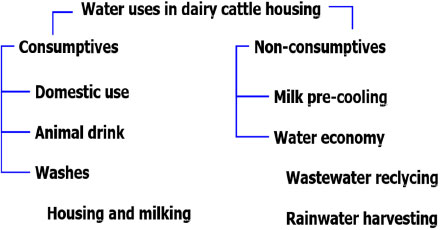

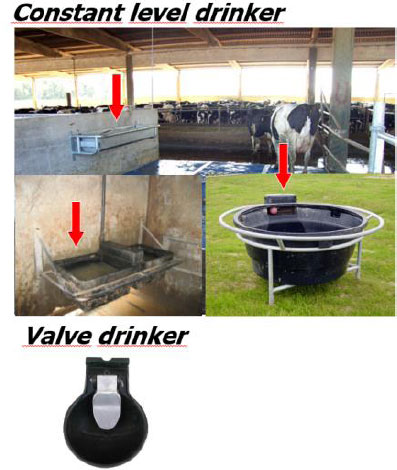
The use of hydraulic dragging systems for waste allows the automation of the floor cleaning operation, resulting however in a substantial increase in the amount of effluents produced [23]. Another way of controlling water consumption associated with cleaning facilities for dairy cows is to adjust the procedures for washing floors (slatted or solid) and equipment, for example, using hoses with flow control devices in the respective nozzle or performing this operation as quickly as possible with high-pressure systems [19, 23]. On the other hand, the existence in dairy cattle housing of a V-shaped floor (3% slope) with a central drain (for urine removal) or perforated rough flooring (0.5% perforated area for urine separation) reduces water consumption due to the use of mechanical dragging systems for cleaning operations (Fig. 4).
3.3. Cattle Facilities
The building design used in facilities for dairy cows contributes to the efficient use of water due to the reduction of evaporation of water from floors, transpiration, and water intake by the animals, based on the improvement of climate control. Reducing overheating can be achieved through efficient ventilation (lateral and zenithal openings) and the presence of thermal insulation on the roof of buildings (using sandwich tile). The placement of shading nets or the planting of live hedges (bands of native deciduous trees), close to places where animals congregate, also reduces overheating [20, 22, 24].
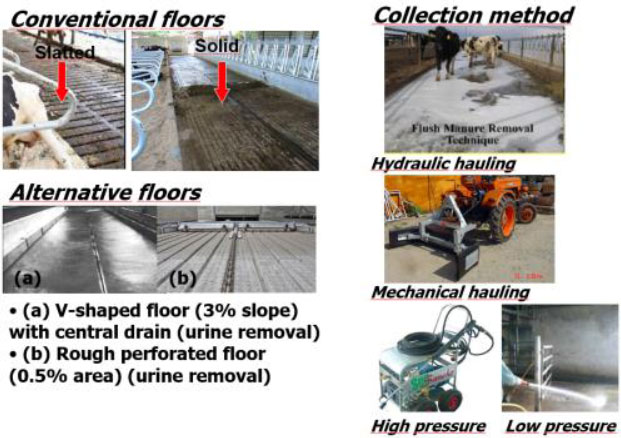
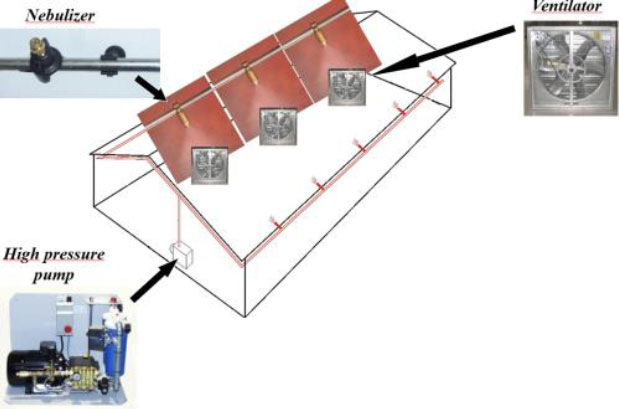
The improvement of the acclimatization of buildings can be carried out using a fogging system (evaporative cooling) (Fig. 5) and vegetation cover on the roofs (green roofs) (Fig. 6) for natural acclimatization. The main technical parameters of a nebulization system for facilities for dairy cows are as follows: nebulizers (0.01 mm droplets, and operating pressure of 60 kPa) with a flow rate of 2 L/m2 (consecutive operating time of 3 minutes) in cycles of 10 in 10 minutes, and with spacing between nebulizers of 1.5 m; air recirculation fans with a flow rate of 360 m3/h (consecutive operating time of 5 minutes), and with a spacing between fans of 5 m; potential to reduce indoor air temperature by 10 ºC; position at the level of the central and/or longitudinal axis of the building, and 2 m above the floor [20, 24, 25]. The main characteristics of a green roof for dairy cow facilities are as follows: vegetation cover with a mixture of species from permanent rainfed pastures, a substrate layer 80-120 mm deep, a drainage layer 250 mm deep, and periodic maintenance vegetation cover (fertilization, irrigation, and cover cutting).
The average value of water needed for washing housing is around 50 L/animal day, while the water used in milking parlours is 14-22 L/animal day with pressure washing and 27-45 L/animal day with pressure-less washing [23, 26, 27]. The use of high-pressure washing equipment reduces the aforementioned water consumption. The use of a heat exchanger using cold water to pre-cool the milk, as well as the storage of hot water from the recovery of the condensation heat from the tank, allows reducing water consumption in the milking parlour [18].
4. WATER REUSE
The reuse of water is a frequent practice, allowing the same water to be used again, four times on average, for example, clean water is used in the milk cooling process; then, this water is used for washing and cooling the cows, and this same water is collected, stored, and used for cleaning the facilities. Finally, this nutrient-rich water is used for irrigating forage crops in the nearby fields.
4.1. Harvest Rainwater
The reuse of water originating from the capture and storage of rainwater has the advantages of increasing the availability of water in the operation, not requiring a capture license, and requiring reduced costs [18]. Table 1 presents examples of estimating the volume of rainwater potentially collected from the roofs of facilities for dairy cows, and Fig. (7) describes technical solutions for capturing rainwater from roofs.
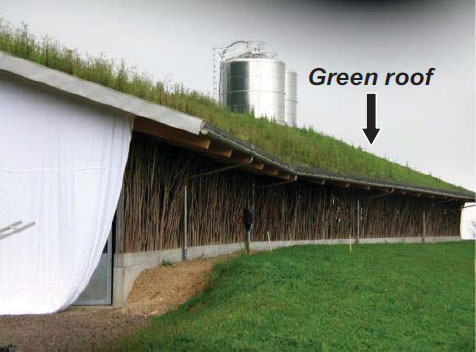
| Roof Area for Rainwater Collection | Average Annual Precipitation | |
|---|---|---|
| 1000 mm | 1500 mm | |
| 2000 m2 | 1620 m3 | 2430 m3 |
| 3000 m2 | 2430 m3 | 3645 m3 |
| 4000 m2 | 3240 m3 | 4860 m3 |
Filtration factor for rainwater = 0.9.
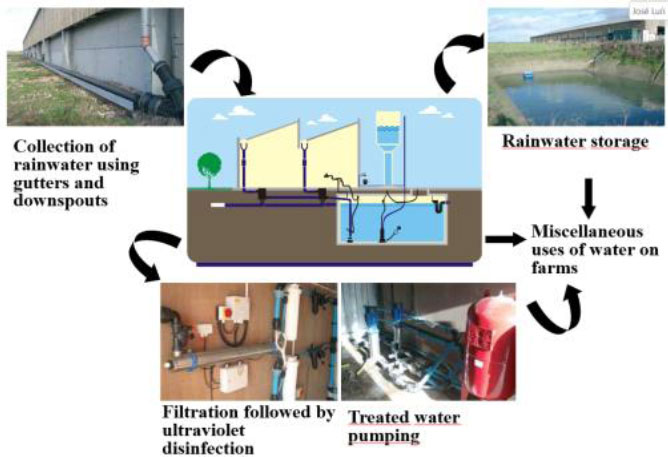
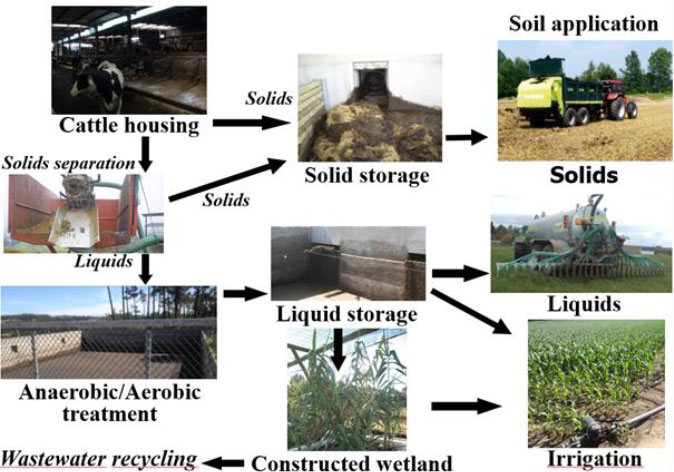
4.2. Effluent Management
Fig. (8) describes technical options for managing and treating cattle effluents from the perspective of recycling treated effluent for washing facilities and irrigation. Treatment technologies for effluent management include physical-chemical separation of solids, anaerobic or aerobic treatment, and vegetative treatment [23, 27-29]. The separation of solids can be done using press or centrifuge equipment, combined or not with chemical separation using flocculating agents (aluminum sulphate or polyacrylamides). The anaerobic treatment can be carried out by digesters or anaerobic lagoons, while the aerobic treatment can be carried out in lagoons/tanks with discontinuous, semi-continuous, or continuous aeration. The vegetative treatment can be carried out in one or two stages, using rooted plants (reeds) in constructed wetlands or floating aquatic plants (swamp lily) in lagoons.
If these effluents are recycled for washing facilities and irrigation, it is possible to significantly reduce the volumes of water involved in this operation. For recycling to take place properly, it is necessary to consider treatment systems in order to ensure the maintenance of hygienic and sanitary conditions in the facilities and equipment for pumping and transporting effluents [30].
5. IRRIGATION SYSTEMS
With the use of drip irrigation and other water efficiency practices, more dairy farms are significantly reducing their water consumption and improving water quality protection, while reducing greenhouse gas emissions [31]. This includes adopting an underground drip irrigation system that also applies farm manure effluent directly to the root zone. This technique has demonstrated an increase in water efficiency, using less water, while maintaining or increasing crop yields [32].
Likewise, the multitude of technological options available in recent decades is becoming a driving force for the transition to smarter farming systems [33]. The efficient and effective management of water in irrigation is one of the main benefits arising from recent agricultural technologies [16].
In this context, the adoption of improved irrigation technologies has been highlighted as a strategic tool at the farm level to improve the sustainability of irrigation and water resources. Such improvements bring a range of benefits, including water conservation, more efficient resource use, improved farmer welfare [34], reduced input costs, and increased crop yields [35]. In addition, the transition to a more efficient irrigation system will become even more important as the impacts of climate change become more pronounced [36].
Instead of traditional irrigation, knowledge and technology-based intelligent irrigation is receiving more and more attention due to advantages, such as automatic controllability and feasibility in optimizing crop yield and irrigation water use efficiency [16]. Examples of these include the use of remotely sensed data (from drones or satellites), and the availability of sensors and communication networks.
5.1. Remote Sensing
Remote sensing (RS) has been the subject of extensive research in recent years with regard to its application in the efficient management of water use due to its ability to cover large irrigated areas and provide rapid measurements and easy access to crop information. In contrast to conventional methods, such as soil probes or plant-based techniques, RS is able to determine the water status of plants on a spatial scale [37]. Currently, crop water levels are estimated using RS data, and on this basis, it is possible to program irrigation. Satellite images combined with ground-based measurements are one of the tools that make it possible to use algorithms to obtain vegetation indices in order to estimate evapotranspiration (ET) in large areas [38]. Images acquired by a thermal infrared sensor (TIRS) on the current Lansat-8 satellite series (30m spatial resolution) allow the determination of spatial variability information of actual ET at the field scale and uniformity of water consumption [39].
Farg et al. [40] conducted a study using RS imagery to evaluate the efficiency of water distribution under a center-pivot system. Landsat OLI 8 satellite data were used to estimate and map water depth. The imagery was subjected to geometric and radiometric corrections to calculate the normalized difference vegetation index (NDVI), normalized difference water index (NDWI), and land surface temperature (LST). According to the authors, the collected water depth in the watersheds was strongly negatively correlated with NDVI, while water depth was positively correlated with NDWI and LST. In addition, Mendes et al. [41] developed an intelligent fuzzy inference system that can generate prescriptive maps to control the rotation rate of a central pivot, using satellite images (Fig. 9). Based on the variable rate irrigation prescriptive map, generated by the intelligent decision-making system, the pivot can increase or decrease its speed to achieve the desired application depth in a specific irrigation zone of the field. As a result, the authors concluded that edaphoclimatic variable data, when well fitted to fuzzy logic, can solve uncertainties and nonlinearities of an irrigation system and create a control model for high-precision irrigation.
Crop evapotranspiration (ETc) maps developed from remotely sensed multispectral vegetation indices are also a valuable tool for farmers as they allow adequate amounts of irrigation water to be applied at each stage of crop growth, resulting in significant water savings [42, 43]. Thus, as the efficiency of irrigation water use increases, the water-saving potential of irrigation area gradually increases [44]. A study conducted by Reyes-González et al. [45] reported the use of RS technology to estimate actual ET and predict crop coefficient (Kc) in fodder crops. A relationship was established between NDVI derived from satellite imagery and Kc from the literature to determine new Kc values for maize and alfalfa. New Kc curves were created for fodder crops. Estimated crop water consumption on actual ET was calculated for maize and alfalfa, representing irrigation water savings of 25% and 32%, respectively. According to the authors, the use of RS technology can improve water management and irrigation water savings. Furthermore, a similar study [46] reported the development of a regression model between NDVI and Kc

values to generate Kc maps and, subsequently, local and regional ETc maps with high spatial resolution, providing a useful tool for accurately estimating crop water requirement and ETc. In addition, Karam et al. [47] reported an RS application to improve crop water allocation in a scarce water resource environment. According to the authors, when RS data are used, water demand can be reduced by 10-22%, which means a significant saving of water for irrigation purposes. Cropping maps were created within a geographic information system (GIS) to define different cultivation calendars and predict seasonal water requirements for irrigation at the pilot area level. The authors concluded that satellite imagery was critical in defining existing cultivation patterns in the pilot area and helped to better determine seasonal irrigation needs.
The use of thermal and multispectral imagery captured by unmanned aerial vehicles (UAV) or drones is another remote sensing approach to identify trends and make adjustments in irrigation. According to Cozzolino [41], the temperature of the plant canopy correlates with the water status of the plants and can, therefore, be used for irrigation management. On the other hand, applications using reflectance in the near and mid-infrared range of the electromagnetic spectrum allow, for example, the determination of the water stress index of the plants [41].
5.2. Sensor and Communication Networks
Sensors are important tools that allow the collection of tremendous data, with the aim of improving the management of agricultural land. Soil moisture probes and weather stations are typical examples of sensors used in irrigation management. Traditionally, crop or soil moisture monitoring devices are connected with cables and generally require manual readings, making the process more time-consuming. In addition, they are site-specific, not suitable for use in large areas, and could be inaccurate and often expensive [37].
On the other hand, the development of wireless sensor technologies has increased in recent decades and has provided low-cost and energy-efficient smart sensors that are used to monitor various parameters in the field, such as soil moisture and meteorological data. A wireless sensor network (WSN) consists of spatially distributed autonomous devices that use sensor nodes [48, 49], connected to each other through a wireless connection module (Fig. 10). Sensor networks may also have actuators that can be used to automate the irrigation system. The wireless communication technologies currently used for agricultural purposes, including water management, are wireless fidelity (WiFi), Bluetooth, GPRS/3G/4G, long-range radio (LoRa), SigFox, and ZigBee technology [50], which are most widely preferred for irrigation control due to their range, low cost, energy efficiency, and reliability [51]. The use of wireless sensors makes it possible to measure humidity, temperature, and soil moisture content, and transmit the data via the internet. Automating this important data collection means that the irrigation system can be controlled in real-time, resulting in higher water use efficiency [37].

An automated irrigation system based on an embedded platform with an ARM microcontroller and using a wireless sensor network and GPRS technology was developed by Avatade and Dhanure [53]. Soil moisture content and temperature are measured and monitored with multiple wireless sensor nodes. The system controls the flow of water in the field based on the measured values to reduce water consumption for irrigation and allows monitoring and control of the status of the sensors through a remote connection PC via the internet. In addition, Nagarajan and Minu [54] developed an automated soil monitoring device using WSN to automate a sprinkler irrigation system. In this device, ZigBee technology is used for data transmission and GPRS technology is used for data storage and analysis. The entire system is powered by solar cells. Soil pH, temperature, and moisture content are monitored using a number of different sensors, and the collected data are sent to a controller for monitoring purposes. Furthermore, the device allows the control and optimization of the water supply. Afolabi et al. [55] developed an automated irrigation system using the WSN to develop and evaluate its performance in different soil types: clay, loamy, and sandy soil. The developed device consists of a WSN in which multiple sensors remotely monitor and control soil moisture and other soil conditions.
Several researchers have also reported that sensor and communication networks could also play an important role in water conservation [56, 57]. According to Muñoz-Carpena and Dukes [58], sprinkler irrigation with sensor applications can improve water efficiency by up to 80-90% compared to 40-45% for surface irrigation. In an earlier study [59], it was concluded that 16% of water can be saved with this irrigation method. Feng et al. [60] developed an automated crop irrigation system employing WSN and general packet radio service (GPRS) modules, based on data collected by soil moisture and temperature sensors installed in the crop root zone. According to the authors, up to 90% water savings could be achieved compared to traditional agricultural irrigation practices. Finally, a remotely controlled automatic irrigation system was developed and tested by Damas et al. [61]. A pilot area was divided into seven sub-regions, which were monitored and supervised by a control sector. All the control sectors were connected to each other and to the central controller via a wireless local area network. As a result, relevant water savings of up to 30-60% have been achieved.
CONCLUSION
In this review, we have observed that there are no studies that can be compared or provide information on water consumption taking into account the various factors that influence water consumption. However, at dairy farms, water footprint can be reduced by implementing practices involving proper feeding of animals, ventilation, maintenance of water systems, reuse and utilization of wastewater and irrigation water, as well as using the water circulating in the heat exchange systems to cool the milk after milking for drinking and irrigating fields.
To maintain the sustainability of livestock production systems and meet the food needs of a growing population, given the dwindling water resources, it is essential to implement water-saving strategies and technologies. The use of technological options is the key driving force for transitioning to smarter farming systems and efficient water use at dairy farms.
The water consumption of dairy cows must be monitored to ensure that their needs are adjusted to the type and system of feeding, thereby avoiding wasting water.
The use of information and communication technologies may enable more efficient use of water in irrigation systems in pasture production. Thus, to achieve water footprint targets, dairy farms are recommended to implement the above water-saving technologies and strategies based on various conditions, such as location, weather conditions, environmental policies, and financial resources.
LIST OF ABBREVIATIONS
| WU | = Water use |
| GNSS | = Global navigation satellite system |
| GF | = Water footprint |
CONSENT FOR PUBLICATION
Not applicable.
FUNDING
This research was funded by National Funds from FCT - Portuguese Foundation for Science and Technology, under the projects UIDB/04033/2020 (CITAB) and UIDB/00681/2020 (CERNAS).
CONFLICT OF INTEREST
Dr. José L. S. Pereira is the Editorial Board Member of The Open Agriculture Journal.
ACKNOWLEDGEMENTS
Declared none.


